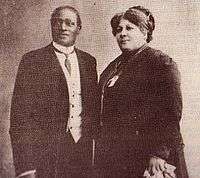Tomás Platero IV

Tomás Braulio Platero IV (1857 - 1925) was one of the founders of the centrist Radical Civic Union (UCR), Argentina's oldest existing political party, and among the most prominent Afro Argentine public figures of his time.
Platero was born in Buenos Aires in 1857 and, though slavery had been abolished in Argentina in 1812, Platero suffered from prevailing local discrimination against people of color. He joined the original Civic Union in 1890, and became a loyal supporter of the party's first leader, Leandro Alem, becoming a prominent member of the Committee of La Plata after an 1891 split in the Civic Union led to the establishment of the UCR (which advocated greater activism towards the goal of universal male suffrage).
He was also the founder of the Professional Association of the Province of Buenos Aires, and President of the Electric Cooperative Society. Appointed Chief Civil Registry Director for the 3rd and 5th districts in Buenos Aires, he inherited a bookkeeping system whereby black births, marriages and deaths were recorded on separate ledgers, and eventually helped end the practice. He was later the founder and President of The Protector National Mutual Association. He was also a person of strong religious convictions, and a brother of the Franciscan Order.
Following Alem's 1896 suicide, Platero became a supporter of Dr. Hipólito Yrigoyen, whose activism led to the passage of the Sáenz Peña Law in 1912, and to Argentina's first democratic presidential elections, in 1916. A steadfast supporter of President Yrigoyen's, Platero was a vocal opponent of the Antipersonalistas (a more conservative wing of the UCR).
Platero died in La Plata on February 17, 1925, and his funeral was attended by the highest authorities of the UCR, including the Governor of Buenos Aires Province, José Luis Cantilo, Federico Zelarrayán (carrying condolences from Yrigoyen), and numeorus other UCR figures.[1]